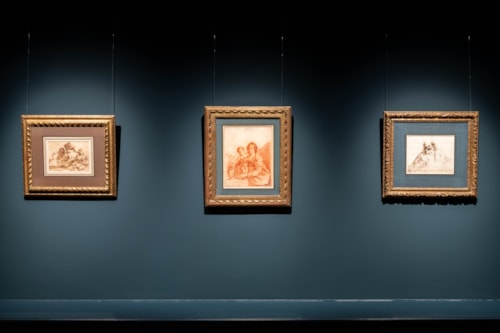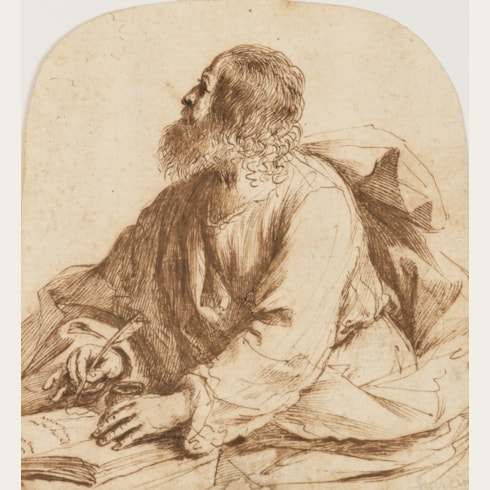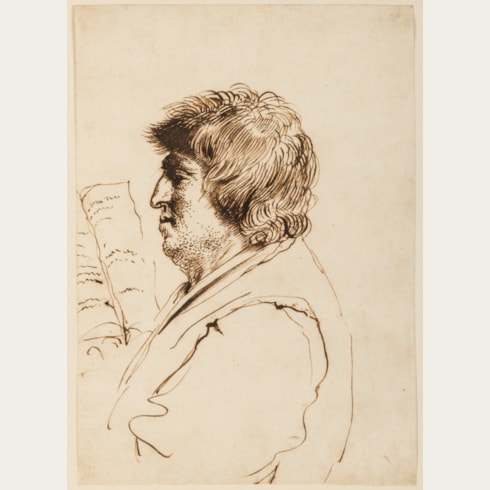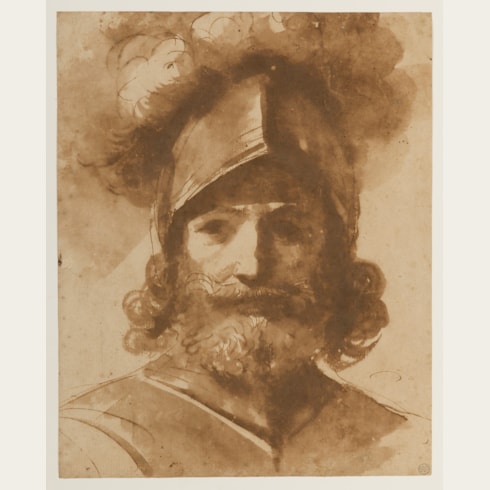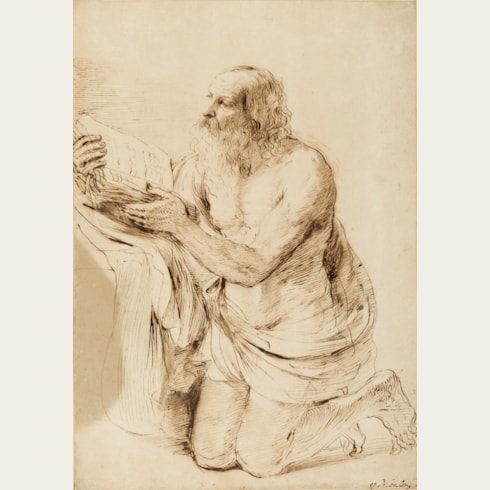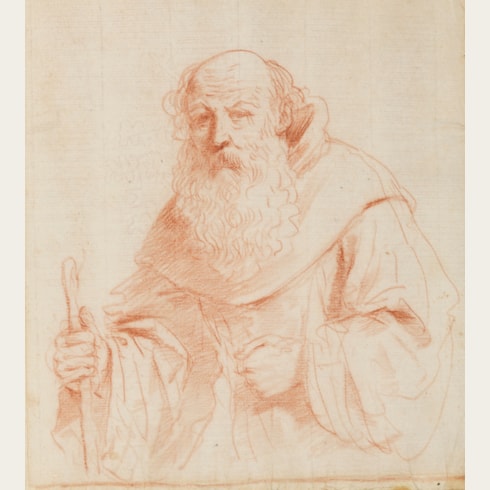Giovanni Francesco Barbieri GUERCINO
(Cento 1591 - Bologna 1666)
The Prophet Isaiah with a Scroll
The sheet backed with thin Japan paper.
210 x 247 mm. (8 1/4 x 9 3/4 in.) [sheet]
As Turner has written of the present sheet and the related canvas of 1648, ‘Drawing and painting correspond closely in general conception, but as was typical of the artist he was keen to consider as many options as possible before arriving at a final design. In the drawing, the prophet inclines his head to the left as he looks downwards at the scroll, which he holds loosely in his hands at either end. In the painting, he looks downwards slightly to the right but instead of a scroll he holds a piece of paper firmly in both hands, inscribed: EGO DOMINUS PRIMUS ET NOVISSIMUS EGO / SUM/ ISAIAE CAPE 35.’
A closely related pen and ink drawing of Isaiah reading a scroll, but in three-quarter length format, appeared at auction in New York in 2006. Turner has further noted that ‘Though the ex-New York drawing is more finished than the present sheet, it must have been drawn earlier, since it surely represents a first idea for the painting. Nevertheless, the fluttering pen lines with a fine nib are identical to those in the present sheet, confirming that the two studies were made at about the same time. The many differences between the two illuminate Guercino’s process of self-revision as he worked on a given composition.’ Another study associated with the 1648 canvas, drawn in red chalk on the reverse of part of a letter, was formerly in the collection of Jak Katalan and appeared at auction in 1991 and 1994, and is closest to the figure of Isaiah in the final painting.
Guercino’s 1648 painting of Isaiah is similar in composition, albeit in reverse, to an earlier bust length painting of Saint Luke the Evangelist, painted in 1631 and given by the artist to Cardinal Giulio Sacchetti of Ferrara; long considered lost, the painting has appeared on the art market twice in recent years.
A very similar pen and ink study of the head of an old man looking down, albeit in reverse to the present sheet, is in the collection of the Princeton University Art Museum, while a compositionally related pen and ink drawing of the same subject, attributed to an artist in the workshop of Guercino, is in the Albertina in Vienna.
Giovanni Francesco Barbieri, known as Il Guercino (‘the squinter’) because he was cross-eyed, was by the second decade of the 17th century one of the leading painters in the province of Emilia. Born in Cento, a small town between Bologna and Ferrara, Guercino was largely self-taught, although his early work was strongly influenced by the paintings of Ludovico Carracci. In 1617 he was summoned to Bologna by Alessandro Ludovisi, the Cardinal Archbishop of Bologna, and there painted a number of important altarpieces, typified by the Saint William Receiving the Monastic Habit, painted in 1620 and now in the Pinacoteca Nazionale in Bologna. When Ludovisi was elected Pope Gregory XV in 1621, Guercino was summoned to Rome to work for the pontiff and his nephew, Cardinal Ludovico Ludovisi. It was in Rome that Guercino painted some of his most celebrated works, notably the ceiling fresco of Aurora in the Casino Ludovisi and the large altarpiece of The Burial and Reception into Heaven of Saint Petronilla for an altar in Saint Peter’s. The papacy of Gregory XV was short-lived, however, and on the death of the Pope in 1623 Guercino returned to his native Cento. He remained working in Cento for twenty years, though he continued to receive commissions from patrons throughout Italy and beyond, and turned down offers of employment at the royal courts in London and Paris. Following the death of Guido Reni in 1642, Guercino moved his studio to Bologna, where he received commissions for religious pictures of the sort that Reni had specialized in, and soon inherited his position as the leading painter in the city.
Guercino was among the most prolific draughtsmen of the 17th century in Italy, and his preferred medium was pen and brown ink, although he also worked in red chalk, black chalk, and charcoal. He appears to have assiduously kept his drawings throughout his long career, and to have only parted with a few of them. Indeed, more drawings by him survive today than by any other Italian artist of the period. On his death in 1666 all of the numerous surviving sheets in his studio passed to his nephews and heirs, the painters Benedetto and Cesare Gennari, known as the ‘Casa Gennari’.
The drawings of Guercino, which include figural and compositional studies, landscapes, caricatures and genre scenes, have always been coveted by later collectors and connoisseurs. Indeed, the 18th century amateur Pierre-Jean Mariette noted of the artist that ‘Ce peintre a outre cela une plume tout-à-faite séduisante’. The largest extant group of drawings by Guercino is today in the Royal Collection at Windsor Castle; these were acquired from the Gennari family by King George III’s librarian, Richard Dalton, between about 1758 and 1764.
Provenance
Private collection
Anonymous sale (‘Ancienne collection de Monsieur et Madame C.’), Paris, Pierre Bergé & Associés, 17 December 2020, lot 19
Private collection, London.





